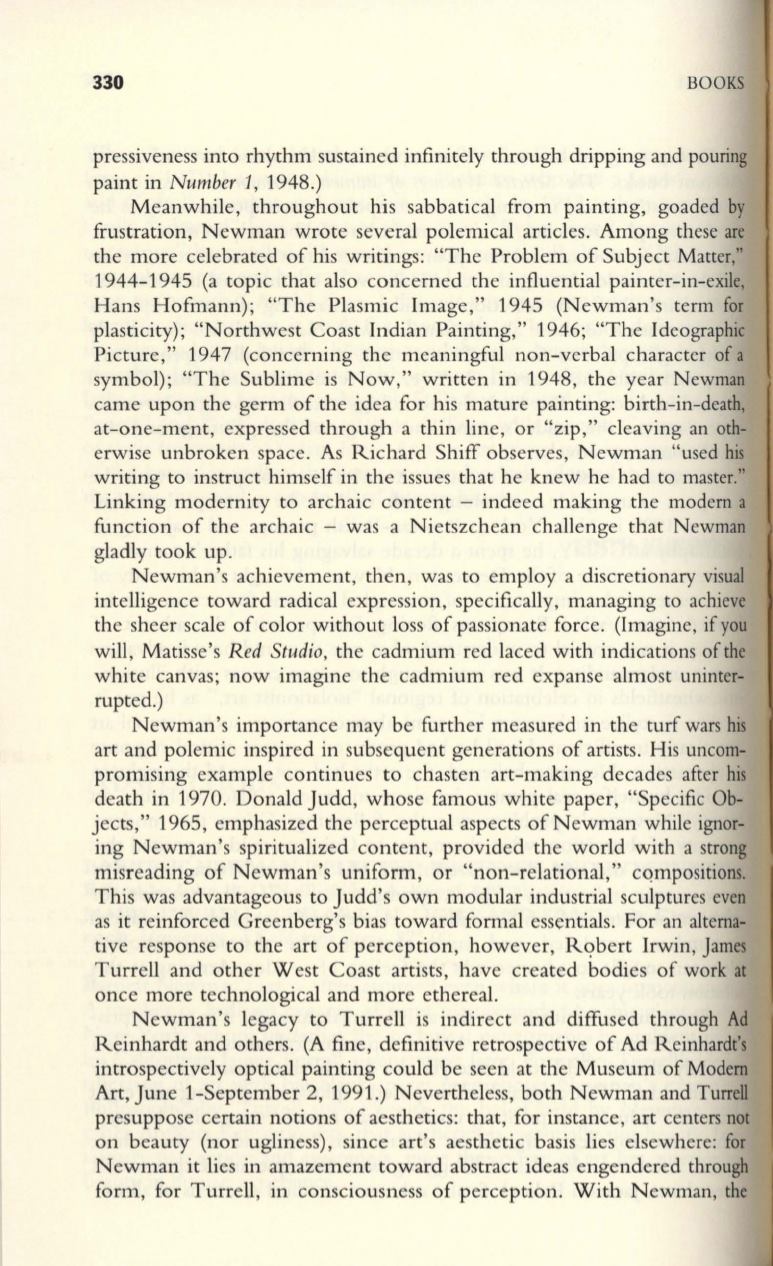
330
BOOKS
pressiveness into rhythm sustained infinitely through dripping and pouring
paint in
Number
1, 1948.)
Meanwhile, throughout his sabbatical from painting, goaded
by
frustration, Newman wrote several polemical articles. Among these are
the more celebrated of his writings: "The Problem of Subject Matter,"
1944-1945 (a topic that also concerned the influential painter-in-exile,
Hans Hofmann); "The Plasmic Image," 1945 (Newman's term for
plasticity) ; "Northwest Coast Indian Painting," 1946; "The Ideographic
Picture," 1947 (concerning the meaningful non-verbal character of a
symbol); "The Sublime is Now," written in 1948, the year Newman
came upon the germ of the idea for his mature painting: birth-in-death,
at-one-ment, expressed through a thin line, or "zip," cleaving an oth–
erwise unbroken space. As Richard Shiff observes, Newman "used his
writing to instruct himself in the issues that he knew he had to master."
Linking modernity to archaic content - indeed making the modern a
function of the archaic - was a Nietszchean challenge that Newman
gladly took up.
Newman's achievement, then, was to employ a discretionary visual
intelligence toward radical expression, specifically, managing to achieve
the sheer scale of color without loss of passionate force. (Imagine, if you
will, Matisse's
Red Studio,
the cadmium red laced with indications of the
white canvas; now imagine the cadmium red expanse almost uninter–
rupted.)
Newman's importance may be further measured in the turf wars his
art and polemic inspired in subsequent generations of artists. His uncom–
promising example continues to chasten art-making decades after his
death in 1970. Donald Judd, whose famous white paper, "Specific Ob–
jects," 1965, emphasized the perceptual aspects of Newman while ignor–
ing Newman's spiritualized content, provided the world with a strong
misreading of Newman's uniform, or "non-relational," cQmpositions.
This was advantageous to Judd's own modular industrial sculptures even
as it reinforced Greenberg's bias toward formal essentials. For an alterna–
tive response to the art of perception, however, R<?bert Irwin, James
Turrell and other West Coast artists, have created bodies of work at
once more technological and more ethereal.
Newman's legacy to Turrell is indirect and diffused through
Ad
Reinhardt and others. (A fine, definitive retrospective of Ad Reinhardt's
introspectively optical painting could be seen at the Museum of Modem
Art, June I-September 2, 1991.) Nevertheless, both Newman and Turrell
presuppose certain notions of aesthetics: that, for instance, art centers not
on beauty (nor ugliness), since art's aesthetic basis lies elsewhere: for
Newman it lies in amazement toward abstract ideas engendered through
form, for Turrell, in consciousness of perception. With Newman, the


